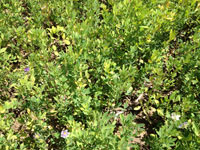CropWatch July 18, 2014
As of Monday, 74% of the state's corn was rated good to excellent. Thirty-three percent was at silking, near the 5-year average of 32%. Soybeans were 72% good to excellent with 55% of the crop blooming, well ahead of 40% for the 5-year average. (Photo by Patrick Wright)
July 18, 2014

Soybean Production
- Cool Conditions May Lead to White Mold in Soybeans. Outbreaks develop during flowering stage, particularly under cooler temperatures.
- It's Time to Begin Scouting for Soybean Aphid. While few aphids have been reported so far, this could quickly change under the right conditions. See aphid biology, beneficial predators, and scouting methods and apps.
- Managing Soybean Aphids. Treatment thresholds, recommendations, and why you still need to scout resistant varieties.
- CropWatch SCN Poll: What you Said. Two-thirds of respondents say sampling is on their radar for this year.
Wheat Production
- Common Bunt (Stinking Smut) in Wheat. There are reports of common bunt of wheat, also known as stinking smut, in a wide area from western Nebraska into eastern Colorado.
- Control Volunteer Winter Wheat Now for Higher Yields Next Year. Each year wheat producers lose millions of dollars in potential income by not controlling volunteer winter wheat and providing a green bridge for wheat streak mosaic.
- Controlling Weeds Post-Harvest in Winter Wheat Timely control of weeds following winter wheat harvest can limit soil moisture loss to weeds and prevent the deposit of more weed seeds in the soil, two factors that can benefit the next crop's yield.
- Wheat Production Workshop Aug. 4 at the UNL Panhandle Center. Register by July 28.
- Soybeans and Sunflowers as Forage after Wheat. Consider your forage needs and whether these might be good options this year.
Storm Damage
- Storm Damage Response Information. 2013 CW articles offer information to help with post-storm management decision-making.
- More Storm Damage Articles (2014)
Insect and Disease Management
- The Economic Injury Level and the Economic Threshold in IPM. How these terms differ and why understanding the difference is important to your pest management strategies.
- Plant Disease Reports by District for Corn and Soybean. See what's being reported where.
- Light Trap Reports for south central, west central, and northeast sites.
Crop Reports

- Field Reports from Extension. Wheat harvest is about to begin in the Panhandle and insects and diseases are generally staying at low levels.
Market Journal
- Segments from this week's Market Journal cover timely weed control after wheat harvest, managing spray drift, planting forages into wheat stubble, and the current grain market.
IANR & Extension Programs